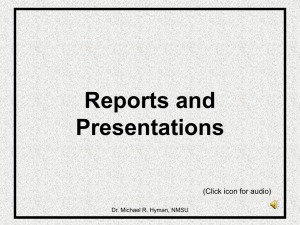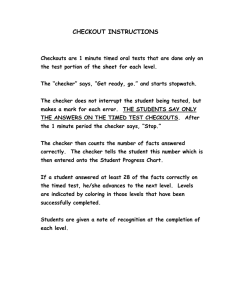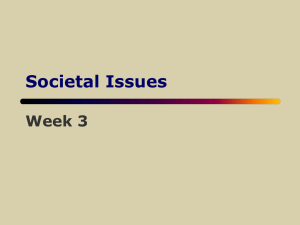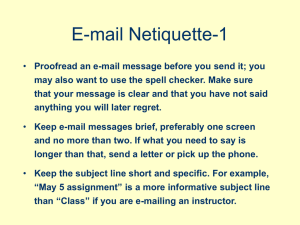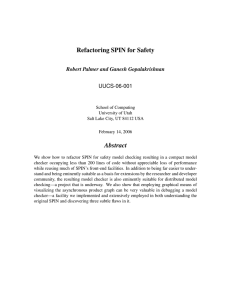The W3C mobileOK Checker - The W3C Markup Validation Service
advertisement
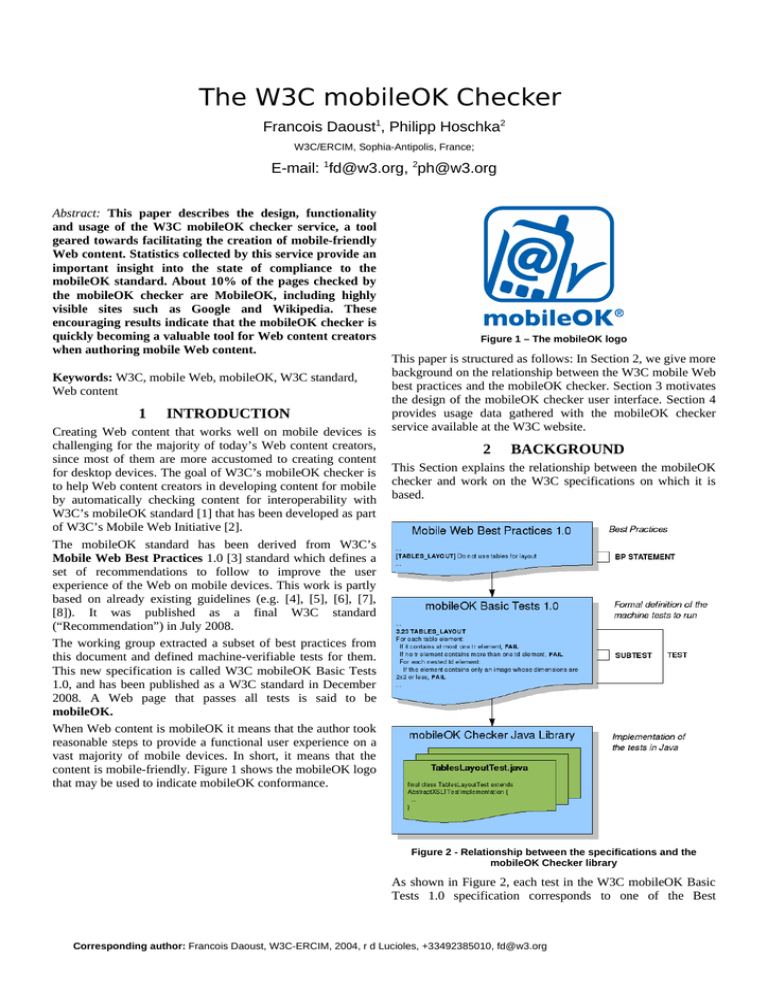
The W3C mobileOK Checker Francois Daoust1, Philipp Hoschka2 W3C/ERCIM, Sophia-Antipolis, France; E-mail: 1fd@w3.org, 2ph@w3.org Abstract: This paper describes the design, functionality and usage of the W3C mobileOK checker service, a tool geared towards facilitating the creation of mobile-friendly Web content. Statistics collected by this service provide an important insight into the state of compliance to the mobileOK standard. About 10% of the pages checked by the mobileOK checker are MobileOK, including highly visible sites such as Google and Wikipedia. These encouraging results indicate that the mobileOK checker is quickly becoming a valuable tool for Web content creators when authoring mobile Web content. Keywords: W3C, mobile Web, mobileOK, W3C standard, Web content 1 INTRODUCTION Creating Web content that works well on mobile devices is challenging for the majority of today’s Web content creators, since most of them are more accustomed to creating content for desktop devices. The goal of W3C’s mobileOK checker is to help Web content creators in developing content for mobile by automatically checking content for interoperability with W3C’s mobileOK standard [1] that has been developed as part of W3C’s Mobile Web Initiative [2]. The mobileOK standard has been derived from W3C’s Mobile Web Best Practices 1.0 [3] standard which defines a set of recommendations to follow to improve the user experience of the Web on mobile devices. This work is partly based on already existing guidelines (e.g. [4], [5], [6], [7], [8]). It was published as a final W3C standard (“Recommendation”) in July 2008. The working group extracted a subset of best practices from this document and defined machine-verifiable tests for them. This new specification is called W3C mobileOK Basic Tests 1.0, and has been published as a W3C standard in December 2008. A Web page that passes all tests is said to be mobileOK. When Web content is mobileOK it means that the author took reasonable steps to provide a functional user experience on a vast majority of mobile devices. In short, it means that the content is mobile-friendly. Figure 1 shows the mobileOK logo that may be used to indicate mobileOK conformance. Figure 1 – The mobileOK logo This paper is structured as follows: In Section 2, we give more background on the relationship between the W3C mobile Web best practices and the mobileOK checker. Section 3 motivates the design of the mobileOK checker user interface. Section 4 provides usage data gathered with the mobileOK checker service available at the W3C website. 2 BACKGROUND This Section explains the relationship between the mobileOK checker and work on the W3C specifications on which it is based. Figure 2 - Relationship between the specifications and the mobileOK Checker library As shown in Figure 2, each test in the W3C mobileOK Basic Tests 1.0 specification corresponds to one of the Best Corresponding author: Francois Daoust, W3C-ERCIM, 2004, r d Lucioles, +33492385010, fd@w3.org Practices statements of the Mobile Web Best Practices 1.0 specification. A test consists of several atomic subtests. A subtest can pass, fail, or generate a warning. Warnings serve to draw the attention of developers to specific areas where additional work may be needed, but do not cause a subtest to fail. The mobileOK Checker Java library is an implementation of the mobileOK Basic Tests 1.0 specification. It can be used to rapidly verify whether a Web page is mobileOK or not. The W3C Mobile Web Best Practices Working Group developed a test suite to validate the conformance of the mobileOK Checker library against the mobileOK standard. The library passes the tests and has been approved as a reference implementation by the group. It may thus be used to claim mobileOK conformance. The community is starting to pick up the open-source library and integrating it into other projects [9]. The public-mobileokchecker@w3.org mailing-list receives requests from developers, using the library within their own products and raising questions as to how they could extend it to suit their own needs (e.g. by adding some more tests). External take-up of the mobileOK Checker Java library is a very important outcome of this work, since it will avoid developer confusion around mobileOK due to inconsistent implementations of independently developed checker tools ; the library underwent a major overhaul early 2009 focused on extensibility [10]. The source code of the library is available at: http://dev.w3.org/cvsweb/2007/mobileok-ref/ 3 CHECKER USER INTERFACE 3.1 General Overview The Java library is a low-level tool, intended for developers. Consequently, the failure messages returned by the library are rather technical and do not explain why the failure is important and how it may be fixed. In order to address a larger community of Web content developers, a higher level view is required that is comprehensible by users who are not necessarily used to developing (mobile) Web content. Experience gathered running the very popular W3C Markup validator [11] helped design the new interface. The final user interface, released as version 1.0 in November 2008, greatly enhanced the quality of the mobileOK report, in particular by structuring reports in a view per category and by completing messages with additional information such as links to external tutorials. A global score that measures the level of “mobileOKness” of a page is provided to encourage incremental improvements on Web page. Figure 3 - The mobileOK checker home page Figure 3 shows the home page of the version 1.0 of the on-line mobileOK checker. The live version of the checker installed at the W3C site is available at: http://validator.w3.org/mobile The source code of the mobileOK checker user interface is available at: http://dev.w3.org/cvsweb/2008/mobileok-webui/ 3.2 Failure Reports The users of the mobileOK checker can choose to view failure reports either by category or by test. 3.2.1 View Failures by Category The default view is a view per category. Its aim is to group the subtest messages using the different categories relevant to Web content creators such as markup errors, mistakes in the structure of the page, stylesheet errors, HTTP errors and others. Each category is described by some introductory text that explains what the subtests in the category intend to check. 3.2.2 View Failures by Test When developers become more familiar with the Mobile Web Best Practices, they may want to ensure that a particular test is respected, and directly view that information. For this reason, it is also possible to view the report per test. This additional view follows the structure of the mobileOK Basic Tests 1.0 specification, and thus of the Mobile Web Best Practices 1.0. 3.3 Scoring a page Experience with the W3C Markup validator showed that “allor-nothing” reports (“Valid” or “Not Valid”) fail to encourage users to fix the underlying problems. As long as a page is not valid, an “all-or-nothing’ report keeps displaying a big red “Not valid” response. Initially, the mobileOK Checker followed the same approach. No matter how many failures an author would fix, the tool would not give a more encouraging report until the author reached full mobileOK status. Corresponding author: Francois Daoust, W3C-ERCIM, 2004, r d Lucioles, +33492385010, fd@w3.org This is not always optimal, or even justified. For instance, in the case of mobileOK, the size of the content (including embedded resources such as images) must not exceed 20KB. Clearly, if the size is 22KB, the content may not be mobileOK, but it is still close to being mobileOK, and far better than a page that returns 500KB of data. To alleviate this issue, the mobileOK Checker now returns a global score between 0 and 100 for the “mobileOKness” of a page (see Figure 4). Each time the page is improved, the score increases, providing a sense of achievement to the content creator making the improvement. These numbers indicate that the mobileOK checker service is successful and is being adopted by mobile content authors to check and improve content while it is being developed. Figure 4 - Score and page statistics example This incremental score is an experimental feature. If successful, it could also be incorporated into future versions of other validator tools at the W3C. 3.4 Severity levels Figure 5 - Evolution of usage of W3C mobileOK checker service 4.2 State of the Mobile Web The statistics collected allow us to draw some conclusions on the state of the mobile Web. A severity level accompanies each failure message to help authors prioritize the improvements required to make the page mobileOK. As with scoring, the idea is to encourage timeconstrained authors to address critical failures first, and let them decide whether they have enough time to address the remaining less critical issues. 3.5 Statistics on the page The mobileOK checker displays statistics on the size of the page and the number of HTTP requests needed to retrieve the resources (see Figure 4). This information helps content creators to spot that the CSS style sheets are too big or that the links within the resource could be updated to skip a few costly HTTP redirections. The information given also helps to answer questions that have a particular impact on the user experience in a mobile context such as “how long would it take to render the page on a given network?” or “how much would it cost if the user is not under a flat data plan?” 4 USAGE Each use of the mobileOK checker installation on the W3C web site is logged in significant detail. This allows computing interesting statistics on its usage. 4.1 Evolution As shown in Figure 5, the usage of the mobileOK Checker was fairly constant between April 2008 (when the new logging mechanism was introduced) and June 2009, averaging at about 3000 requests per week. Usage increased significantly in December 2008 when version 1.0 was officially released, including an improved user interface. The number of distinct Web addresses checked in this period is 58432. Web addresses were checked 4 times on average. Web addresses were checked 11 times on average before they became mobileOK with the last check. Figure 6 - Repartition per number of subtests failed Specifically, we are able to generate detailed statistics on the number of failures on each page checked for the first six months of logs (see Figure 6). Looking at the numbers, about 10% of the pages checked were mobileOK (5960 out of 58432 Web addresses checked). Examples of highly visible mobileOK Web sites include the Google search engine, the official mobile version of Wikipedia, the T-Online content portal, and the “Remember the milk” Todo-list-tracker [12]. Interestingly enough, about 23% of the pages checked were actually very close to being mobileOK – they failed on less than three subtests. These results show that conforming to the mobileOK standard is achievable in practice, i.e. it is possible to create mobileOK Corresponding author: Francois Daoust, W3C-ERCIM, 2004, r d Lucioles, +33492385010, fd@w3.org Web content. Furthermore, it shows that mobile web developers aspire to be mobileOK when authoring mobile web content, and are actually adopting the standard. Note that the Web pages checked by the mobileOK Checker are not necessarily representative of the whole Web. The pages come from users that explicitly chose to use the mobileOK checker. This does introduce a bias in the sample oriented towards mobile-friendliness – checking random pages on the Web would likely a much lower percentage of “mobileOKness”. Up-to-date mobileOK Checker statistics results are accessible at: http://www.w3.org/2008/04/mokstats/public 4.3 Level of Adherence to Best Practices Since all mobileOK tests can be linked back to one of the Mobile Web Best Practices, it is possible to compute the ten best practices that most frequently cause failures in the Web addresses checked by the tool (see Table 1). Looking at the results, a number of points stand out. First, content validity is an important aspect of the mobile Web, and is already taken into account by many mobile authors. The statistics of the mobileOK Checker show that 25% of the pages checked are valid XHTML Basic. In contrast, a recent study from Opera [13] on several millions of ”general” Web addresses shows that only about 4% of those were valid. Moreover, caching is not addressed at all in 40% of the Web addresses checked. Caching is a rather technical topic and is easily forgotten. Increased education and outreach on caching techniques would probably help to raise the awareness on the importance of allowing responses to be cached in mobile networks, thereby reducing latency and potential data transmission costs for the user. Finally, tables for layout and pop-ups are still used in about 30% of the Web addresses checked. This is another area that could benefit from more education. Table 1 - Mobile Web Best Practices most frequently not followed Best Practice Failures (%) Create documents that validate to published formal 75% grammars. Do not use pixel measures and do not use absolute 55% units in markup language attribute values and style sheet property values. Indicate in the response the character encoding being 52% used. Send content in a format that is known to be supported 52% by the device. Ensure that the overall size of page is appropriate to 50% the memory limitations of the device. Specify the size of images in markup, if they have an 46% intrinsic size. Provide caching information in HTTP responses. 40% Do not use tables for layout. 33% Do not cause pop-ups or other windows to appear and 27% do not change the current window without informing the user. Broken links. 27% Looking at the other side of the spectrum, Table 2 shows the five best practices that least frequently cause failures. Looking at these results, it appears that some best practices are already followed by most content creators. In particular, frames and auto-refresh are hardly used anymore. Some of these results should be interpreted with caution, however. First, the test that detects the presence of graphics for spacing is not complete because it is impossible to detect all cases automatically. Graphics for spacing are usually used in combination with tables for layout, so the actual percentage of failures in this category is probably higher (tables for layout are detected in 33% of all cases). Second, the best practice on the default text entry mode is only applied when an XHTML 1.1 inputmode attribute is defined. Given that the inputmode attribute is a fairly recent addition to XHTML, the low percentage of failures indicates a lack of use of this attribute rather than a best practice that is particularly well respected. Corresponding author: Francois Daoust, W3C-ERCIM, 2004, r d Lucioles, +33492385010, fd@w3.org Table 2 - Mobile Web Best Practices least frequently not followed Use terse, efficient markup. 4% page. An additional NOT_APPLICABLE outcome (rather than PASS) would help improve the way the score for the page is computed, and help generate even more meaningful statistics. Do not use frames. 4% 5.6 Widget Checker Do not use markup to redirect pages automatically. Instead, configure the server to perform redirects by means of HTTP 3xx codes. 2% Do not use graphics for spacing. 2% Specify a default text entry mode, language and/or input format, if the device is known to support it. <1% Best Practice 5 Failures (%) FUTURE WORK The release of the mobileOK checker version 1.0 is a big step forward to promote the development of mobile friendly content but work does not stop here. This Section outlines some further directions for future work. 5.1 Report improvements based on feedback The report returned by the mobileOK Checker strives to not make any assumptions about the technical knowledge of the user. That said, it is difficult to account for all the possibilities that may cause a given failure. The public-mobileokchecker@w3.org mailing-list serves as a central point to gather feedback. This feedback is valuable to understand how authors understand the failures reported, and to update the messages consequently. 5.2 Towards a decision-making tool Scoring and severity levels mentioned earlier are the first steps towards shifting the mobileOK Checker away from a failure reporting tool to a decision-making tool, where Web authors, or project managers, can find out easily the severity and costs associated with failures reported by the checker, and plan updates according to the time they are willing to spend on improving the mobile-friendliness of their pages. 5.3 Direct input checking The mobileOK Checker only checks publicly available Web pages. Web pages may not always be available on the Web. They may be private or may have not been published yet. The mobileOK Checker should offer the possibility to check Web pages directly from user input, even though mobileOK checks that apply at the HTTP level cannot be run in such cases. 5.4 Web site batch processing The mobileOK checker can be used to check a single page, but there is currently no way to process all pages in a Web site. One way to do that could be to give a seed page to the Checker along with a maximum depth to check. The Checker would then follow the links and check the resulting pages. The mobileOK Checker library features a generic testing framework of which mobileOK is but a specific profile. Other profiles may be specified, and an alpha version of a Widget Checker was developed [14] that checks conformance to the Widgets packaging specification [15]. This new Checker should be released as a stable v1.0 by the end of 2009. Acknowledgement Work on the mobileOK checker is part of the MobiWeb 2.0 project supported by the European Union's 7th Research Framework Programme (FP7). References [1] mobileOK Basic Tests 1.0, Sean Owen, Jo Rabin, W3C Proposed Recommendation, 3 November 2008, http://www.w3.org/TR/2008/PRmobileOK-basic10-tests-20081103/ [2] About the Mobile Web Initiative, Dominique Hazael-Massieux, http://www.w3.org/Mobile/About [3] Mobile Web Best Practices 1.0, Jo Rabin, Charles McCathieNevile, W3C Recommendation, 29 July 2008, http://www.w3.org/TR/2008/RECmobile-bp-20080729/ [4] Web Content Accessibility Guidelines 1.0, W Chisholm, I. Jacobs, G Vanderheiden, Editors, W3C Recommendation, 5 May 1999, http://www.w3.org/TR/1999/WAI-WEBCONTENT-19990505/ [5] Making Small Devices Look Great, Opera Software, 14 March 2007, http://my.opera.com/community/dev/device/ [6] Best Practices in XHTML Design, Openwave, http://developer.openwave.com/dvl/support/documentation/guides_and_refere nces/best_practices_in_xhtml_design/index.htm [7] S60 Platform: Designing XHTML Mobile Profile Content, Nokia, 24 May 2005, http://sw.nokia.com/id/4f7b6805-47d7-4914-885c6ef2b487adf6/Series_60_Platform_Designing_XHTML_MP_Content_v1_4_ en.pdf [8] Browsing on Mobile Phones, Virpi Roto, MobEA III workshop on Customer Focused Mobile Services, in conjunction with WWW2005 conference. May 10, 2005, Chiba, Japan. (2005), http://www.research.att.com/~rjana/WF12_Paper1.pdf [9] W3C MobileOK Basic Tests 1.0 Checker Extension Supporting file URI Scheme, Human Centred Web Lab, http://hcw-eprints.cs.man.ac.uk/87/ [10] Extensibility of the mobileOK Checker Java library, W3C, http://dev.w3.org/2007/mobileokref/docs/org/w3c/mwi/mobileok/basic/package-summary.html#extensibility [11] About the W3C Markup Validation Service, W3C http://validator.w3.org/about.html [12] Remember The Milk: Online to do list and task management, http://www.rememberthemilk.com/ [13] MAMA: “What is the Web made of?”, Brian Wilson (Opera), 15 October 2008, http://dev.opera.com/articles/view/mama/ [14] W3C Widget Checker (Alpha Version), W3C, http://qadev.w3.org:8001/widget/ [15] Widgets 1.0: Packaging and Configuration, Marcos Cáceres, W3C Candidate Recommendation, 23 July 2009, http://www.w3.org/TR/2009/CRwidgets-20090723/ 5.5 “Not applicable” outcome At the moment, the outcome of a test can only be PASS or FAIL, but some of the tests are not applicable for some of the Web pages that are being checked by the tool. For instance, checking whether the height and width attributes are set on images only applies when images are actually used in the Corresponding author: Francois Daoust, W3C-ERCIM, 2004, r d Lucioles, +33492385010, fd@w3.org
